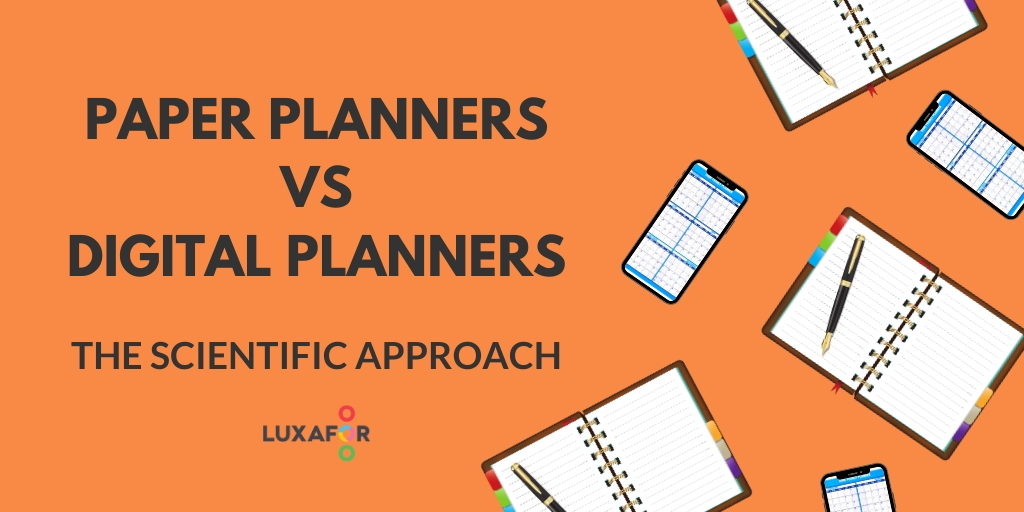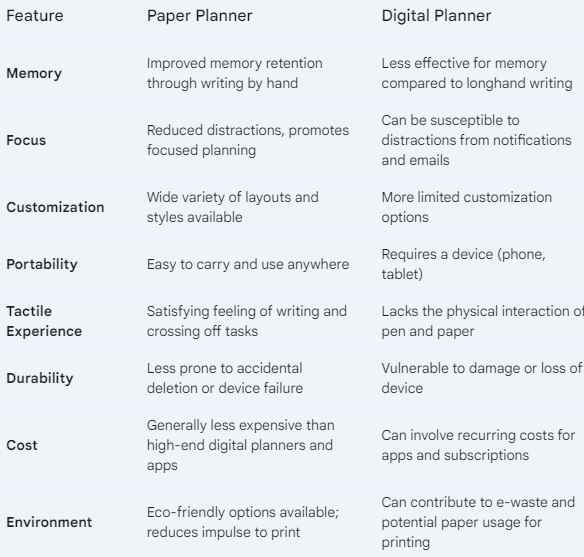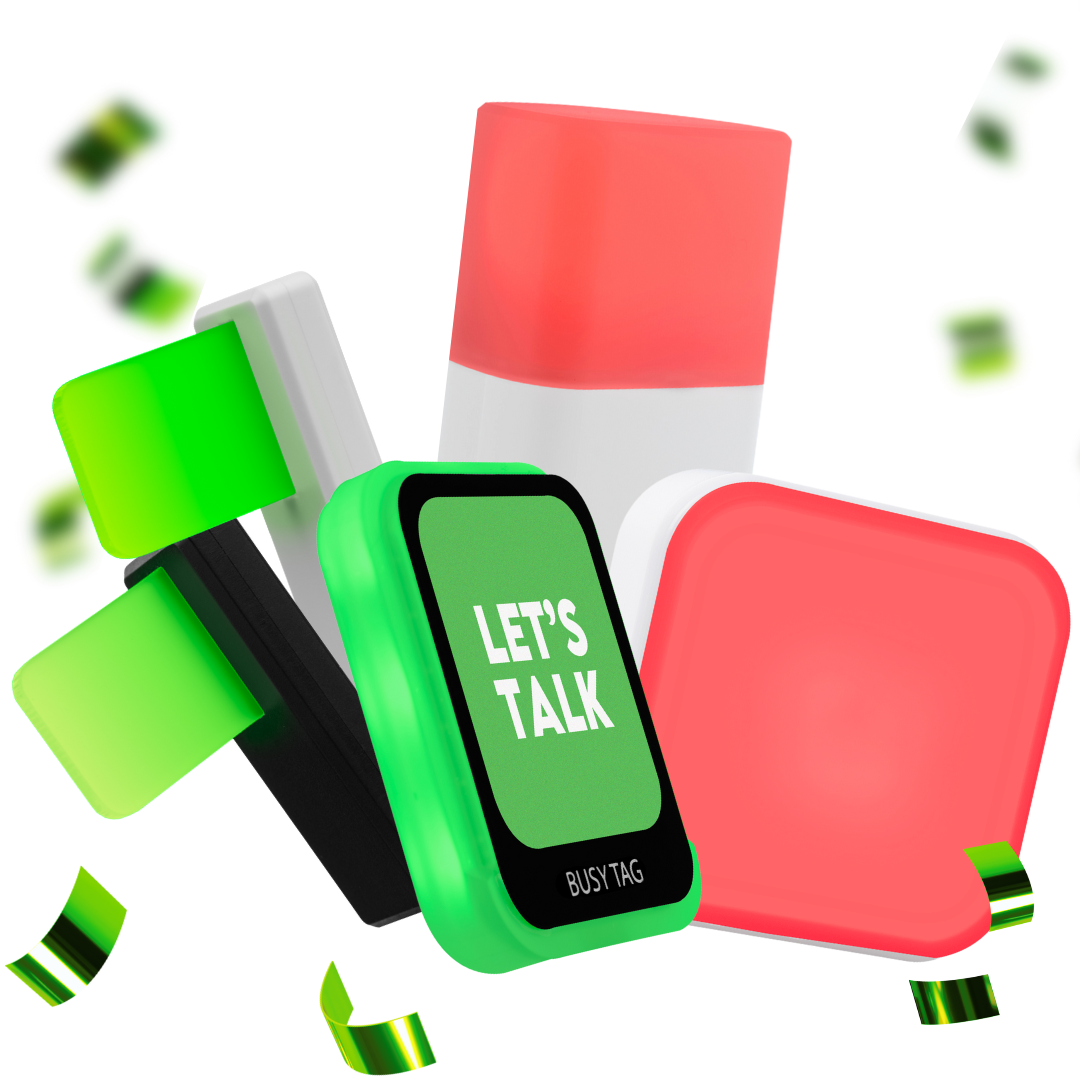5 Reasons Why Paper Planners Are Better Than Digital Planners
- Updated on: January 16, 2025

What is the advantage that electronic scheduling tools have over paper calendars?Well, whether you’re a die-hard business person, freelance artist, stay-at-home parent, or an office regular, you must have a system to plan, organize and prioritize your tasks and events. That system is crucial to getting things done – whether it stays on your Google calendar, all over your fridge on post-its, or on your paper planner.
The rise of digital devices has heavily diminished our habits of note-taking, journaling, and planning set on paper. Do you even remember the last time you wrote down more than 2 sentences by hand? Whatever we do and wherever we go, we seem to never forget to take our phones with us. So, clearly, many are moving their organizational systems to the digital world.
However, despite the trends, the industry of paper planners, agendas, and productivity journals seems to be well off. More and more people are interested in owning a paper agenda and using it daily. This time we wanted to take a deeper look at the matter – what really makes paper planners better than digital planners? What are the benefits?
We did some research and found 5 science-backed benefits you’d enjoy if you switched to a paper planner.
1. You are less distracted

Source: Unsplash
When you think of the pros of digital planners vs. paper planners, many people highlight notifications and reminders. With your phone by your side all the time, planning apps can have recurring reminders and ding at the exact time when you need to take out your dog or plan out your finances for the month. Isn’t it convenient?
But how many notifications do you get per day? And how many of them do you simply swipe away? In the era of pop-ups, dings, and buzzes, we have become nearly desensitized to app reminders. We’ve learned to start ignoring the content of the message, as we know that notifications are annoying and distracting per se. No wonder your “Read a book” reminder gets neglected for months!
Studies have found that too much screen time also negatively impacts your brain, so the idea of journaling via phone seems fine and convenient, but nevertheless adds to the problem. Plus, have you ever been carried away by a simple text push notification so much that you end up browsing TikTok or Reddit memes… for hours? That doesn’t sound too worthwhile.
Taking a minute to plan out your day on paper lets your eyes rest for a while, as well as clears your head from that abundance of information we receive in our mailboxes and social media feeds. If you really want to improve your focus by reducing screen time, then definitely switch to paper planners for journaling, idea mapping, organizing tasks and events, poetry writing – whatever! You’ll definitely do your brain a favor in the long run.
There are just so many benefits to writing things down on paper, so keep on reading
2. You remember things better

Source: Unsplash
You’ve probably heard this one, and it’s true – writing stuff down actually helps you to memorize it better. But there’s more to that. Not only writing by hand makes us formulate our plans and to-do’s better, it stimulates certain brain cells at the base of the brain to increase focus.
The physical action – writing – simply triggers this sector, making your brain turn into maximum focus mode. Once you write down a goal, your brain will be working overtime to make you pay attention and remember. There are many studies proving that and one by the Dominican University of California found that people who wrote down their goals, shared them with others, and maintained accountability for their goals were 33% more likely to achieve them, versus those who just formulated goals in their head. Note that!
The screen, therefore, limits that ability, becoming like a shield that distances us from what we write. Simply put, writing by hand is a much more engaging process for your brain, as you form and connect the letters. On the other hand, typing involves arranging letters by pressing keys only. Plus, it’s sort of becoming a muscle memory no-brainer, as many people have learned to type without looking.
3. You are more motivated
Source: Luxafor
Since writing longhand requires more effort, it helps you be more concise and to the point. Of course, it’s way easier and faster to type, but it also makes it harder to be selective about what we write so as to refine our thoughts to the essence. If you’re still in the middle between paper planners and digital apps, compare your notes – it’s very likely that the ones in your app look more verbose and messy.
By writing, we are able to clarify our thoughts and mindfully connect with exactly what we need to do, and what we want and aim for. To save time, it helps to abbreviate events and certain points in your to-do. However, when thinking of your monthly, yearly, and lifetime goals, it really helps to be more precise. If you need assistance with academic tasks, you can always consider services that offer to write my term papers.
After all, there is a strong relationship between our thoughts and the language we use. Therefore, writing your goals down and carefully wording them helps you retain that goal in your mind. And think about how convenient if it’s written right there – in a planner you open every day.
4. Reduced stress
Source: Unsplash
Writing down your plans has far more benefits than simply having a more organized life. Surprisingly, but one of the world’s top digital technological countries – Japan – has a thriving culture of the good old paper agenda.
Wittingly referred to as the “tech (planner) culture.”, the Japanese take time to organize their thinking via pen and paper, stickers, color coding, drawing, etc., with many designing their own unique notation systems similar to the bullet journal concept. In a fast-paced world like Japan, that might be one of the easiest habits to keep a clear mind.
There are many studies that show the link between writing things down by hand and mindfulness. In stress therapy, it is often advised to keep a journal exactly because of the activity’s healing properties. Like an active meditation, writing helps you sort out whatever mess of thoughts you have in your mind into words.
And exactly because of the effort it takes, you get to become more selective with words. That makes you better at defining your feelings, attitudes, and goals. As you register them, it’s easier to deal with them appropriately.
5. It`s your healthy habit
Source: Unsplash
Similarly, as you’re more inclined to commit to your plans and goals when you write them down, having a planner is also a commitment. We are more likely to cling to physical things, rather than digital, because they are real – we can touch them. In a digital world, separated by an impenetrable screen, your commitment to an app gets lost among all the other stuff on your phone, tablet, or computer. A daily planner put nicely on your desk is a great reminder to use it.
Plus, if you’re not really a habit person, then having a paper planner might be the first step towards a positive change. Various studies show that it takes somewhere between 21 to 66 days to form a habit. That means, you only need approximately one month of test mode using your paper planner daily to see how you like it, and make it a habit. The absolutely best part is the chain reaction of good habits that’ll start off.
You can also combine the habits, for example, drink two glasses of water while you do your daily planning – that’s two birds with one stone.
Now, when you combine the five aforementioned steps, what you get is the essentials of productivity. That is to say, having a daily planner really helps to make you a more organized, motivated, and productive person.
We have summarized some of the benefits for the paper planners vs digital planners for you to consider in a table below:
If you’re thinking about switching to a paper planner, here are our tips:
1. Evaluate Your Needs
Think of what fits your typical day. If you’re busy enough to sometimes forget plans in your schedule, then go for a simple dated daily planner. If you like to make long to-do lists, see if the planner has enough space for that. If you like to use your planner for short-term and long-term planning, habit tracking, and improving your productivity, then DO IT, combine that into a superb combo of a classic planner and a positivity journal. You just need to organize it like that.
2. Decide How Much Money You Want To Spend
Set your budget limits. Decide if you really get value for $40, $60, or even $80 price. If you struggle with evaluating the pros and cons, we’ve put together a list of the 11 best productivity planners. For budget-friendly options, here’s our guide to our top 7 picks under $30.
3. Develop A System
If you want to ensure that the planner is fully custom to your personal needs from the very beginning, try using Canvas’ recently revamped Personal Planner Maker. It’s free, easy, and quick! You can easily create and customize daily, weekly or monthly planners as you see fit.
4. Import The Data
Think of what you want to journal, track, measure, and put down in writing. For example, use symbols or colorful stickers to mark habits, and color markers for labeling or prioritizing. However, it is very, very important that you don’t over-complicate it.
If you’re already using a digital planning system, carefully check all your apps and calendars that you track stuff with and transfer to your new planner. Check your recurring tasks and add those in the future areas of your planner. Of course, if you’ve found it easy to stick to a productivity or habit-tracking app of choice, you may as well use a paper and a digital combination for separate areas. You do you!
5. Take Up One-Month Challenge To Use It Daily
Take a month to test out your paper planner and see how using it daily works for you. Set up a reminder in the mornings or evenings and try to take it up as a habit.
When it comes to your productivity, it’s important to adopt habits, systems, and tools that work for you. If you like to keep some things digital, and some on paper, there’s nothing stopping you from that. Whatever works for you is what you need to stick to. Some people might find that paper planners are inefficient for their lifestyle, however, in the era of all things digital, there is strong evidence that writing on paper might be one of the easiest steps toward a healthy and productive life.
The Bottom Line
There are plenty of cognitive benefits of longhand writing, which aids in memory retention and strengthens task focus. Unlike digital devices with their constant notifications, paper planners offer a distraction-free zone for scheduling and prioritizing.
Furthermore, the tactile experience of writing and the satisfaction of physically crossing off completed tasks provide a unique sense of accomplishment often missing in the digital realm.
Overall, using paper planners can improve your focus, and memory, and promote the feeling of gratification, making them a compelling choice for those seeking a more mindful and rewarding planning experience.
Welcome to Luxafor, your one-stop shop for conquering the ever-elusive realm of productivity. We understand the constant struggle to streamline your workflow, achieve goals, and tame the ever-growing to-do list. Does not matter if you’re a seasoned professional, a student overwhelmed by deadlines, or simply someone seeking to optimize your daily routine, Luxafor is here to empower you.
Frequently Asked Questions
Convenience is a definite perk of digital planners. However, paper planners offer unique advantages. Studies show writing things down by hand improves memory and focus compared to typing. Plus, paper planners eliminate distractions from notifications and emails that can plague digital devices.
While digital planners offer easy edits and rescheduling, paper planners can encourage a more mindful approach. The physical act of writing and the visual layout of a paper planner can help you prioritize tasks and stick to your schedule. Plus, there's a wide variety of paper planners available with different layouts and features to suit your specific needs.
Sustainability is a valid concern. There are eco-friendly paper planners made with recycled materials. Additionally, using a paper planner can help you stay organized and avoid the impulse to print out digital documents, potentially reducing overall paper usage.
With a digital calendar, you can view and update your schedule from anywhere with an internet connection, using a computer, smartphone, or tablet. This flexibility allows you to stay organized and manage your time efficiently, regardless of your location.
Do you want to build and maintain new habits? Get your free PDF version of the Don't Break The Chain calendar and start today!
Do you want to build and maintain new habits? Get your free PDF version of the Don't Break The Chain calendar and start today!
Author

Kaspars S.
Productivity tool developer, corporate leader, and technical director at Luxafor.


















